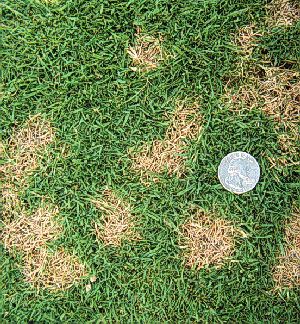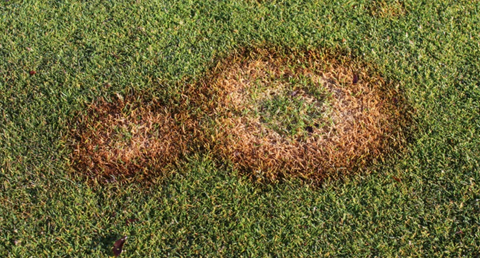Fall, with its cooler temperatures and increased moisture, provides an ideal environment for various types of lawn fungal diseases to emerge and thrive. In this article, we’ll explore common fall lawn fungal diseases, delve into effective prevention strategies and highlight the role of garden hose maintenance in mitigating these issues.
Common Fall Lawn Fungal Diseases
Dollar Spot

Image courtesy of My Home Turf
Dollar spot is a prevalent fungal disease in lawns that manifests as small, circular patches resembling silver dollars. It usually occurs in late summer and early fall when the weather is warm and humid. Infected grass appears bleached and straw-like, with characteristic lesions on individual blades.
Brown Patch

Image courtesy of Turf and Landscape
Brown patch thrives in cool and humid conditions, making it a common fall lawn disease. Infected areas exhibit circular patches of brown, wilted grass with a darker outer ring. The disease targets the grass blades and can quickly spread across the lawn if left unchecked.
Powdery Mildew

Image courtesy of Grass Master
Powdery mildew is characterized by a white, powdery substance that covers grass blades, resulting in a weakened and stunted appearance. It occurs in both humid and dry conditions, making it a threat during the fall season.
Prevention Strategies for Fall Lawn Fungal Diseases
Mow properly: Maintain the correct mowing height for your grass type to encourage healthy growth and discourage disease development. Longer grass blades provide shade and reduce moisture on the soil surface, making it less favorable for fungal growth.
Improve air circulation: Trim overhanging branches and remove debris to enhance air circulation and sunlight penetration throughout the lawn. Fungi thrive in moist, shaded environments, so increasing airflow helps prevent their spread.
Aerate the soil: Aerating the soil helps improve drainage and reduces compaction, creating a less hospitable environment for fungal growth. Fall is an excellent time for aeration when grass is actively growing.
Water wisely: Water the lawn early in the morning to allow ample time for grass blades to dry throughout the day. Avoid late afternoon or evening watering, as prolonged moisture on the grass can promote fungal growth. This is where the proper use of a garden hose comes into play.
The Role of Garden Hose Maintenance
A well-maintained garden hose can significantly contribute to preventing fall lawn fungal diseases. Here’s how:
Use a soaker hose: Instead of overhead watering, consider using a soaker hose or drip irrigation system. These methods deliver water directly to the soil, minimizing moisture on the grass blades and reducing the risk of fungal infections.
Regularly inspect for leaks: Check your garden hose for any leaks, cracks or holes that might lead to uneven water distribution. Even moisture distribution is essential to prevent fungal diseases from taking hold.
Clean your hose: Clean your garden hose regularly to remove any dirt, debris or buildup that can contaminate the water. Contaminated water can introduce harmful pathogens to your lawn, increasing the risk of fungal infections. Also, be sure to drain your hose when you’re not using it. Water left in a hose for extended periods of time can cause bacteria to form.
For more information on garden hose maintenance, check out the Hose Repair and Storage articles on Swanhose.com.
Fall lawn fungal diseases can diminish the beauty and health of your lawn if not properly addressed. By implementing proactive strategies such as proper mowing, improving air circulation and using a well-maintained garden hose, you can effectively prevent these diseases from taking hold. As you prepare your lawn for the upcoming fall season, remember that a combination of thoughtful lawn care practices and attention to your garden hose maintenance can ensure a lush and disease-free lawn to enjoy year-round.
For more lawn care information, read the following articles:
Unlock a Lush Spring Lawn with Expert Fall Care Tips: A Comprehensive Guide
Mastering Leaf Composting: Enhance Your Garden's Potential with Proper Techniques
Leaf-Management Strategies for Fall: Raking, Mulching and Composting Leaves





